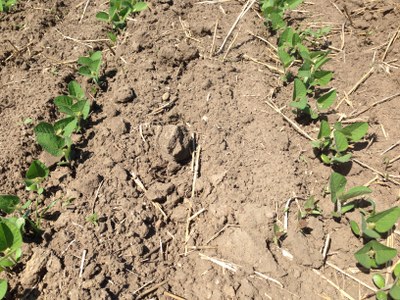Soybean Growth and Development
 The first is the vegetative stage (V) that starts at emergence and leaf development (Table 1). Currently, most soybean are in the unifoliolate stage (see picture). Soybean plant development has two distinct phases. The second phase in the development is the reproductive (R) stage which starts with flowering, followed by pod development, and ends when the seed is fully mature.
The first is the vegetative stage (V) that starts at emergence and leaf development (Table 1). Currently, most soybean are in the unifoliolate stage (see picture). Soybean plant development has two distinct phases. The second phase in the development is the reproductive (R) stage which starts with flowering, followed by pod development, and ends when the seed is fully mature.
Correct production decisions using plant growth stages are important to optimize yield. Information on the development of the soybean plant and various pictures of all the growth stages can be found in the recently reviewed ‘Soybean Growth and Management Quick Guide,’ an NDSU extension publication (A1174) at www.ag.ndsu.edu/pubs/plantsci/rowcrops/a1174.pdf.
Plant stages are determined by the leaf, flower, pod, and seed development within the pods. A leaf is considered fully developed when the leaf at the node directly above it (the next younger leaf) has expanded enough so that the three leaflets, which make up the ‘trifoliolate leaf’ are fully visible. Leaf development will continue during the reproductive phase and plant stature will still increase. The growth stages can overlap. On a field level a growth stage is reached when at least 50% or more of the plants are in or beyond the respective growth stage.
Flowering of the soybean plant is initiated (after the longest day) on the third to sixth main stem node (a node is a part of the stem where a leaf is attached) and continues upward and downward from there. First flowers are usually present during the first half of July.
The critical growth stage in soybean is from the R4-R6 (late pod development to early seed fill). Plant stress during this period will cause more yield reduction than at another time in the plant’s development. The seed is physiological mature when 95% of the pods on the plant have a mature color (R8 stage).
Greg Endres
Area Specialist, Cropping Systems
Hans Kandel
Extension Agronomist


